SUBFAMILY MYRMICINAE - Genus Strumigenys
| The Ants of
Africa SUBFAMILY MYRMICINAE - Genus Strumigenys |
|
| Contents - Myrmicinae - MYRMICINAE Introduction |
Revised by Brown (1954), Bolton (1983) and Bolton (2000).
Diagnostic Features - Antennae 6-segmented, with the second and third funicular segments reduced. Antennal scrobes present. Often the ventrolateral margin of the head is excised in front of the eye to form a preocular notch. Mandibles elongate, linear, with the preapical armament usually of two teeth on the distal portion of the blade, occasionally one of these teeth is missing. Apical armament of the mandible is a fork of two spiniform teeth, with or without intercalary denticles. All orange-brown, some darker.
F Smith's (1860c) genus definition is at ![]() , see also S. mandibularis. An early key to African and Madagascar
dacetines is that of Santschi (1913b); that, with modern annotation, is
, see also S. mandibularis. An early key to African and Madagascar
dacetines is that of Santschi (1913b); that, with modern annotation, is
![]() .
.
Rigato (2006) added two new species - S. alessandrae and S. bartolozzii.
Key to workers of African species (adapted and updated from Bolton, 1983; also plus Bolton, 2000): in addition to the usual measurements, Bolton used ML = straight line length of mandible from anterior clypeal margin to the apex of the mandible, from which he used MI = ML/HL X 100.
| 1 | Preocular notch present; ventrolateral margin of head impressed, notched or indented immediately forward of the eye (may be reduced in adrasora and rukha) | 2 |
| -- | Preocular notch absent; no impression of ventrolateral margin of head forward of the eye | 23 |
| - | Preocular notch present | - |
| 2 | Blade of left mandible with 1 preapical tooth (occasionally with a very small vestige of a second tooth); reticulate-punctate propodeal dorsum | 3 |
| -- | Blade of left mandible with 2 preapical teeth | 7 |
| -- |  Blade of left mandible without preapical teeth;
relatively large TL 3.6 mm, HL 0.96 HW 0.69 CI 72 SL 0.61 SI 88 Blade of left mandible without preapical teeth;
relatively large TL 3.6 mm, HL 0.96 HW 0.69 CI 72 SL 0.61 SI 88 |
Ethiopia - alessandrae |
| - | Blade of left mandible with 1 preapical tooth (occasionally with a very small vestige of a second tooth); reticulate-punctate propodeal dorsum | - |
| 3 | Small TL no more than 2.5 mm | 4 |
| -- | TL at least 2.9 mm | 5 |
| 4 | 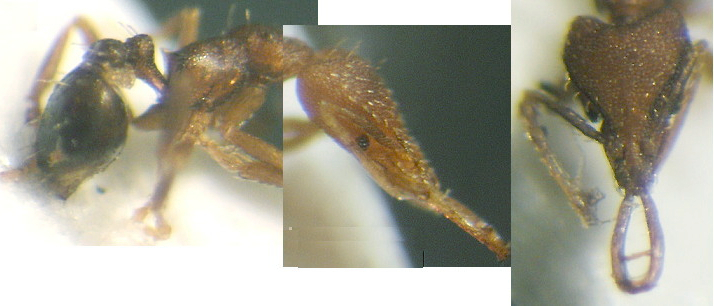 Head with a very narrow profile; apical fork of left
mandible without a small tooth between the spiniform fork; TL 1.7-2.1
mm, HL 0.52-0.58, HW 0.36-0.41, CI 67-72, MI 55-65, SL 0.30-0.36, SI
82-92; variable brown Head with a very narrow profile; apical fork of left
mandible without a small tooth between the spiniform fork; TL 1.7-2.1
mm, HL 0.52-0.58, HW 0.36-0.41, CI 67-72, MI 55-65, SL 0.30-0.36, SI
82-92; variable brown |
Cameroun south to Angola - bernardi (part) |
| -- |  Preocular
notch deep but narrow and not continued across ventral surface of head;
TL 2.3 mm, HL 0.50, HW 0.38, CI 76, MI 54, SL 0.38, SI 98; scapes with
a rearward directed fringe of relatively long narrow hairs; mandibles
relatively short, without hairs on inner margins; pronotum with long
straight hair directed laterally; propodeum with sharp teeth;
postpetiole with a small ventral spongiform lobe; dark brown Preocular
notch deep but narrow and not continued across ventral surface of head;
TL 2.3 mm, HL 0.50, HW 0.38, CI 76, MI 54, SL 0.38, SI 98; scapes with
a rearward directed fringe of relatively long narrow hairs; mandibles
relatively short, without hairs on inner margins; pronotum with long
straight hair directed laterally; propodeum with sharp teeth;
postpetiole with a small ventral spongiform lobe; dark brown |
Tanzania - new species - ulugurensis |
| 4 |  Pronotal humeri with
fine, flagellate hairs; leading edge of scape with 2-4 hairs curved
towards the base; TL 2.4
mm, HL 0.59, HW 0.43, CI 73, MI 47, SL 0.35, SI
81; alitrunk profile relatively short with propounced convexzity of
pronotum; testaceous Pronotal humeri with
fine, flagellate hairs; leading edge of scape with 2-4 hairs curved
towards the base; TL 2.4
mm, HL 0.59, HW 0.43, CI 73, MI 47, SL 0.35, SI
81; alitrunk profile relatively short with propounced convexzity of
pronotum; testaceous(no Antweb images) |
Ethiopia - bartolozzii |
| - | TL at least 2.9 mm |
- |
| 5 | 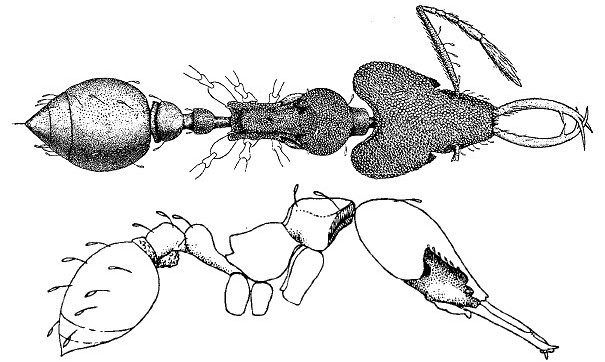 Pronotal humeri with stout feebly clavate straight hairs;
scapes with only a few and variably
directed weakly spatulate hairs;
propodeum without sharp teeth; TL ca 3.0 mm (Bolton has 3.5-4.2 mm) HL
0.84-0.92, HW 0.62-0.70, CI 74-77, MI 51-52, SL 0.52-0.58, SI 82-87;
Patrizi had the colour as testaceous (Bolton gave it as light brown,
gaster darker) Pronotal humeri with stout feebly clavate straight hairs;
scapes with only a few and variably
directed weakly spatulate hairs;
propodeum without sharp teeth; TL ca 3.0 mm (Bolton has 3.5-4.2 mm) HL
0.84-0.92, HW 0.62-0.70, CI 74-77, MI 51-52, SL 0.52-0.58, SI 82-87;
Patrizi had the colour as testaceous (Bolton gave it as light brown,
gaster darker) |
. |
| . |  Tanzania
specimens Tanzania
specimens |
Ethiopia, Kenya & Tanzania - londianensis |
| -- | Pronotal humeri with fine flagellate hairs; mandibles with hairs on inner margins; scapes with rearward directed but relatively short spatulate hairs; propodeum with sharp teeth | . |
| 6 |  Large, HL 1.00 plus; TL
3.8-4.0 mm Large, HL 1.00 plus; TL
3.8-4.0 mm |
Burundi - transenna |
| -- | 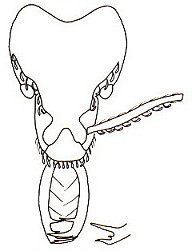 Pronotal
humeri with fine flagellate hairs; mandibles with hairs on
inner margins; TL 2.9, HL 0.72, HW 0.52,
CI 72, MI 53, SL 0.46, SI 88; light brown Pronotal
humeri with fine flagellate hairs; mandibles with hairs on
inner margins; TL 2.9, HL 0.72, HW 0.52,
CI 72, MI 53, SL 0.46, SI 88; light brown |
. |
| . | 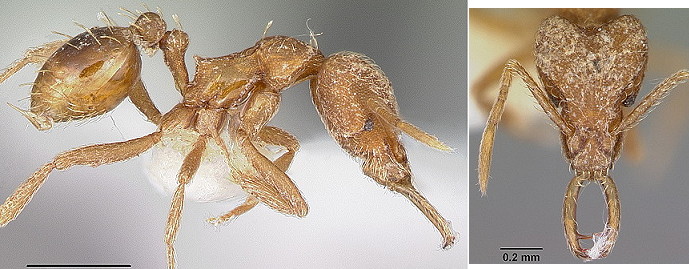 |
Eastern Congo basin & Ethiopia - sarissa |
| Blade of left mandible with 2 preapical teeth | - | |
| 7 | Mandibles straight | 8 |
| -- | Mandibles distinctly bowed | 9 |
| 8 |  In
full-face view head with a distinct notch in the upper scrobe margin
above the eye; whole of alitrunk and pedicel segments densely
spiculate; spongiform appendages on pedicel nodes almost absent; apical
fork of left mandible with a strong intercalary tooth and a denticle
between the spiniform fork teeth; TL 2.7-3.3 mm, HL 0.83-0.92, HW
0.72-0.80, CI 86-91, MI 44-50, SL 0.48-0.50, SI 62-67; dull yellow to
yellowish-brown In
full-face view head with a distinct notch in the upper scrobe margin
above the eye; whole of alitrunk and pedicel segments densely
spiculate; spongiform appendages on pedicel nodes almost absent; apical
fork of left mandible with a strong intercalary tooth and a denticle
between the spiniform fork teeth; TL 2.7-3.3 mm, HL 0.83-0.92, HW
0.72-0.80, CI 86-91, MI 44-50, SL 0.48-0.50, SI 62-67; dull yellow to
yellowish-brown |
. |
| . |  |
West Africa - cacaoensis |
| -- | 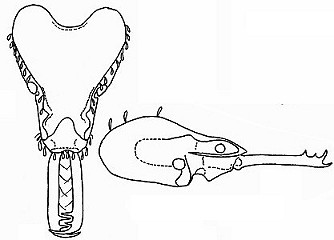 Pedicel
nodes shiny, rest of head and alitrunk sculpture; ventral spongiform
appendages on pedicel nodes well developed; TL 2.2-2.8 mm, HL
0.58-0.74, HW 0.42-0.52, CI 69-75, MI 51-58, SL 0.36-0.46, SI 82-89;
dull yellow to light medium brown or darker Pedicel
nodes shiny, rest of head and alitrunk sculpture; ventral spongiform
appendages on pedicel nodes well developed; TL 2.2-2.8 mm, HL
0.58-0.74, HW 0.42-0.52, CI 69-75, MI 51-58, SL 0.36-0.46, SI 82-89;
dull yellow to light medium brown or darker |
. |
| . | 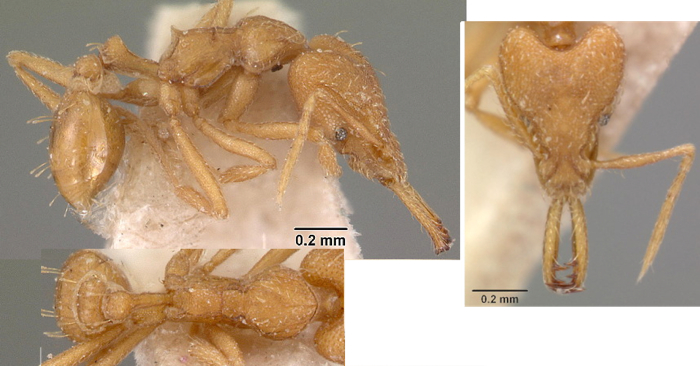 |
Pan-African tropics & tramp - rogeri |
| 9 | 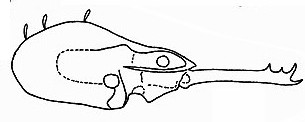 Preocular notch continued on to the ventral surface of the
head as a transverse impression or groove Preocular notch continued on to the ventral surface of the
head as a transverse impression or groove |
10 |
| -- |  Preocular notch not
continued on to the ventral surface of
the head; ventral surface convex and without impressions behind the
post-buccal groove or impression Preocular notch not
continued on to the ventral surface of
the head; ventral surface convex and without impressions behind the
post-buccal groove or impression |
17 |
| 10 | Antennal scapes relatively long (SI 79-92) | 11 |
| -- | Antennal scapes relatively short (SI 64-74) | 12 |
| 11 | 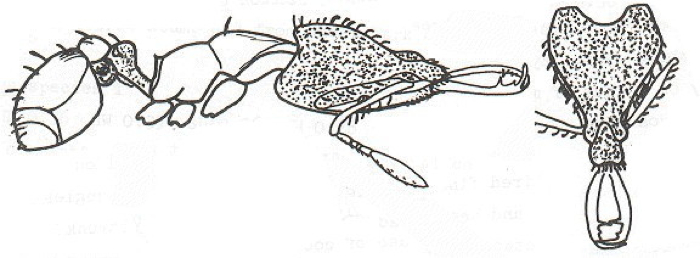 Propodeum
dorsum smooth and shining; TL 1.9-2.2 mm, HL 0.52-0.60, HW 0.36-0.40,
CI 65-70, MI 50-59, SL 0.29-0.34, SI 79-86; dull yellowish-brown Propodeum
dorsum smooth and shining; TL 1.9-2.2 mm, HL 0.52-0.60, HW 0.36-0.40,
CI 65-70, MI 50-59, SL 0.29-0.34, SI 79-86; dull yellowish-brown |
. |
| . | 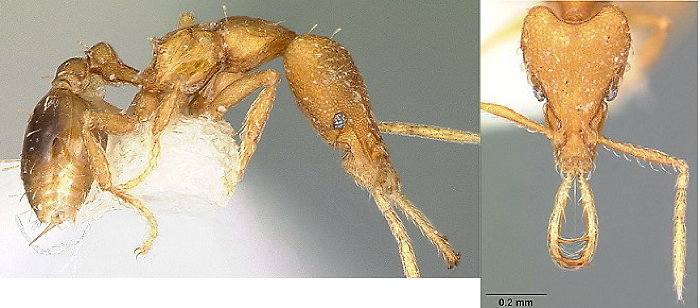 |
West Africa - vazerka |
| -- |  Propodeum dorsum finely reticulate-punctate; TL 1.7-2.1
mm, HL 0.52-0.58, HW 0.36-0.41, CI 67-72, MI 55-65, SL 0.30-0.36, SI
82-92; variable brown Propodeum dorsum finely reticulate-punctate; TL 1.7-2.1
mm, HL 0.52-0.58, HW 0.36-0.41, CI 67-72, MI 55-65, SL 0.30-0.36, SI
82-92; variable brown |
Cameroun south to Angola - bernardi (part) |
| Antennal scapes relatively short (SI 64-74) | - | |
| 12 |  Eyes very large,
maximum diameter 0.23-0.24 X HW; TL
2.3-3.0 mm, HL 0.59-0.70, HW 0.43-0.54, CI 71-77, MI 40-44, SL
0.33-0.40, SI 69-77; dull yellow to light yellowish-brown Eyes very large,
maximum diameter 0.23-0.24 X HW; TL
2.3-3.0 mm, HL 0.59-0.70, HW 0.43-0.54, CI 71-77, MI 40-44, SL
0.33-0.40, SI 69-77; dull yellow to light yellowish-brown |
. |
| . | 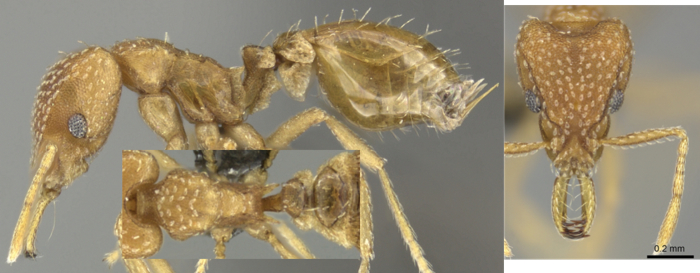 |
Southern Africa - pretoriae |
| -- | Eyes smaller no more than 0.20 X HW | 13 |
| 13 | 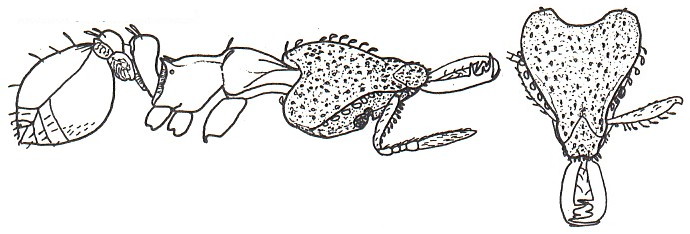 Pronotal
humeri without flagellate hairs; TL 2.0-2.5 mm, HL 0.54-0.68, HW
0.40-0.53, CI 75-83, MI 44-50, SL 0.28-0.36, SI 64-72; variable yellow
to very dark brown, often gaster darker Pronotal
humeri without flagellate hairs; TL 2.0-2.5 mm, HL 0.54-0.68, HW
0.40-0.53, CI 75-83, MI 44-50, SL 0.28-0.36, SI 64-72; variable yellow
to very dark brown, often gaster darker |
. |
| . | 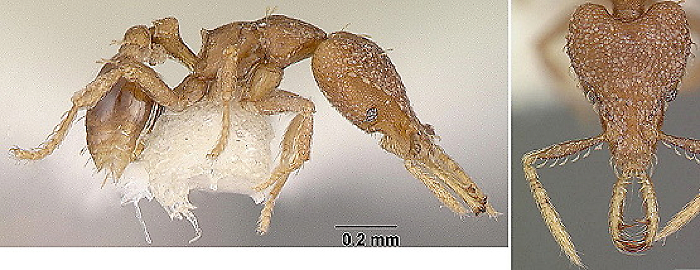 |
West Africa & Congo Basin into S Sudan - petiolata |
| -- | Pronotal humeri with flagellate hairs | 14 |
| 14 |  Postpetiole
dorsum very finely and densely sculptured; TL 2.2-2.3 mm, HL 0.55-0.56,
HW 0.43-0.44, CI 77-79, MI 46-47, SL 0.30-0.32, SI 70-72; dull yellow Postpetiole
dorsum very finely and densely sculptured; TL 2.2-2.3 mm, HL 0.55-0.56,
HW 0.43-0.44, CI 77-79, MI 46-47, SL 0.30-0.32, SI 70-72; dull yellow |
. |
| . |  |
South Africa - faurei |
| -- | Postpetiole dorsum no more than weakly sculptured (may be concealed by a waxy bloom) | 15 |
| 15 |  Distal preapical
tooth of left mandible short and
separated from the proximal tooth by at least the length of the distal
tooth; TL 1.8-2.0 mm, HL 0.48-53, HW 0.36-0.40, CI 73-76, MI 45-48, SL
0.25-0.29, SI 69-74; medium brown, gaster darker (may be wholly dark) Distal preapical
tooth of left mandible short and
separated from the proximal tooth by at least the length of the distal
tooth; TL 1.8-2.0 mm, HL 0.48-53, HW 0.36-0.40, CI 73-76, MI 45-48, SL
0.25-0.29, SI 69-74; medium brown, gaster darker (may be wholly dark) |
. |
| . | 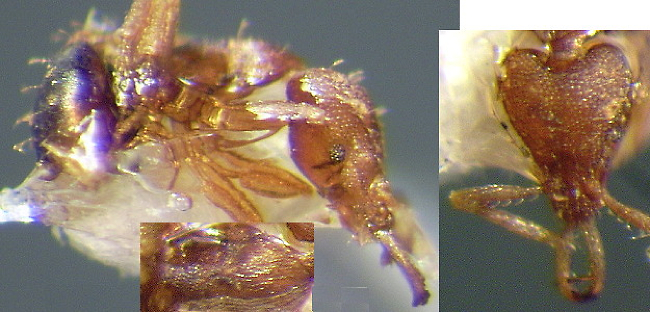 |
West Africa - rufobrunea |
| -- | Distal preapical tooth of left mandible short and separated from the proximal tooth by a distance much less than the length of the distal tooth | 16 |
| 16 |  Extension of preocular notch
on underside of head forming a sharply defined and parallel-sided
groove which is narrower than the width of the eye; TL 2.1-2.3 mm, HL
0.54-58, HW 0.42-0.47, CI 75-81, MI 44-47, SL 0.27-0.31, SI 64-69;
yellowish-brown to light brown Extension of preocular notch
on underside of head forming a sharply defined and parallel-sided
groove which is narrower than the width of the eye; TL 2.1-2.3 mm, HL
0.54-58, HW 0.42-0.47, CI 75-81, MI 44-47, SL 0.27-0.31, SI 64-69;
yellowish-brown to light brown |
Zimbabwe - shaula |
| -- | 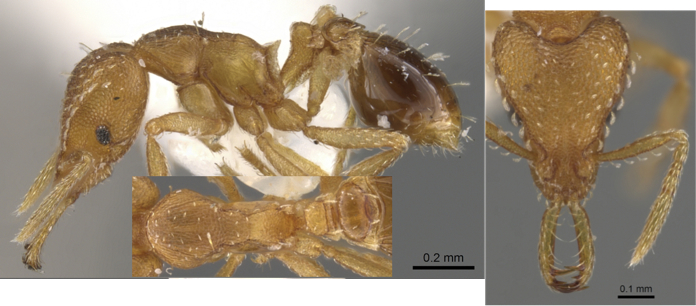 Extension of preocular notch on underside of
head forming a broad dish-like impression as broad as if not broader
than the eye; with rounded edges; TL 2.1 mm, HL 0.54-55, HW 0.40-0.41,
CI 74-75, MI 48-49, SL 0.28-0.29, SI 68-73; brownish-yellow, gaster
dark brown Extension of preocular notch on underside of
head forming a broad dish-like impression as broad as if not broader
than the eye; with rounded edges; TL 2.1 mm, HL 0.54-55, HW 0.40-0.41,
CI 74-75, MI 48-49, SL 0.28-0.29, SI 68-73; brownish-yellow, gaster
dark brown |
Burundi - dromoshaula |
| Preocular notch not continued on to the ventral surface of the head; ventral surface convex and without impressions behind the post-buccal groove or impression | - | |
| 17 |  Eyes small with only 8
ommatidia; mandibles with outer edge straight; TL 2.2 mm, HL 0.59, HW
0.43, CI 73, MI 49, SL 0.34, SI 79; dull brownish yellow Eyes small with only 8
ommatidia; mandibles with outer edge straight; TL 2.2 mm, HL 0.59, HW
0.43, CI 73, MI 49, SL 0.34, SI 79; dull brownish yellow |
Angola - helytruga |
| -- | Eyes with more than 8 ommatidia; mandibles with outer edge convex; SI 65-77 | 18 |
| 18 |  Pronotal
humeri without flagellate hairs; TL 2.3 mm, HL 0.64, HW 0.45, CI 70, MI
44, SL 0.34, SI 76; yellow Pronotal
humeri without flagellate hairs; TL 2.3 mm, HL 0.64, HW 0.45, CI 70, MI
44, SL 0.34, SI 76; yellow |
. |
| . | 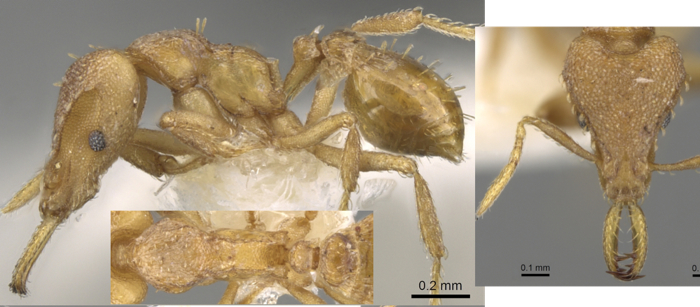 |
Cameroun & Gabon - totyla |
| -- | Pronotal humeri with flagellate hairs | 19 |
| 19 |  In full-face view the projecting hairs on the leading
edges of the scapes large and broadly spoon-shaped; upper scrobe
margins with a broad lamellate rim or flange; TL 2.3 mm, HL 0.61-0.67,
HW 0.48-0.53, CI 79-83, MI 48-51, SL 0.34-0.36, SI 68-71; dull yellow In full-face view the projecting hairs on the leading
edges of the scapes large and broadly spoon-shaped; upper scrobe
margins with a broad lamellate rim or flange; TL 2.3 mm, HL 0.61-0.67,
HW 0.48-0.53, CI 79-83, MI 48-51, SL 0.34-0.36, SI 68-71; dull yellow |
. |
| . |  |
Congo Basin - xenohyla |
| -- | 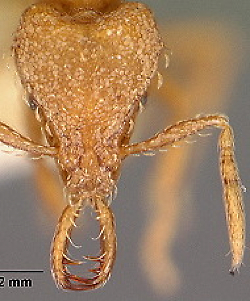 In full-face view the
projecting hairs on the leading
edges of the scapes slender and narrower than those on the upper scrobe
margins, or slender in both places; scrobe margins with a narrow rim or
flange In full-face view the
projecting hairs on the leading
edges of the scapes slender and narrower than those on the upper scrobe
margins, or slender in both places; scrobe margins with a narrow rim or
flange |
19A |
| 19A |  In full face view mandibles
not curved outwards and near parallel sided; dark brown to black; TL
2.8-3.0 mm HL 0.66-0.78 HW 0.51-0.60 SL 0.40-0.46 PW 0.31-0.38 In full face view mandibles
not curved outwards and near parallel sided; dark brown to black; TL
2.8-3.0 mm HL 0.66-0.78 HW 0.51-0.60 SL 0.40-0.46 PW 0.31-0.38 |
Tanzania - percrypta |
| -- | In profile ventral spongiform lobe on postpetiole at least equalling the visible area of postpetiole dorsum; lamella on propodeal declivity broad and involving the teeth | 20 |
| 20 | 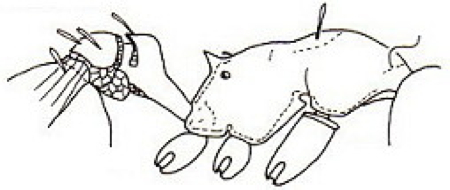 In profile ventral
spongiform lobe on postpetiole much
smaller than visible area of postpetiole dorsum; lamella on propodeal
declivity much reduced; TL 2.3-2.4 mm, HL 0.59-0.62, HW 0.44-0.47, CI
73-78, MI 50-54, SL 0.33-36, SI 72-77; blackish-brown to black In profile ventral
spongiform lobe on postpetiole much
smaller than visible area of postpetiole dorsum; lamella on propodeal
declivity much reduced; TL 2.3-2.4 mm, HL 0.59-0.62, HW 0.44-0.47, CI
73-78, MI 50-54, SL 0.33-36, SI 72-77; blackish-brown to black |
. |
| . | 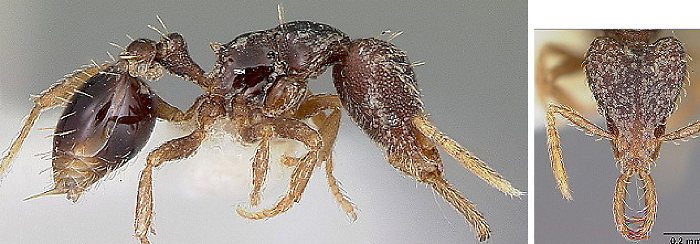 |
Rwanda & Burundi - adrasora (part) |
| -- | In profile ventral spongiform lobe on postpetiole at least equalling the visible area of postpetiole dorsum; lamella on propodeal declivity broad and involving the teeth | 21 |
| 21 |  In dorsal view postpetiole with spongiform material
projecting laterally at and in front of the dorsum; TL 2.3-2.4 mm, HL
0.57-0.60, HW 0.44-0.46, CI 75-79, MI 47-49, SL 0.30-33, SI 67-73;
yellow In dorsal view postpetiole with spongiform material
projecting laterally at and in front of the dorsum; TL 2.3-2.4 mm, HL
0.57-0.60, HW 0.44-0.46, CI 75-79, MI 47-49, SL 0.30-33, SI 67-73;
yellow |
East Africa - rukha (part) |
| -- | In dorsal view postpetiole with spongiform material restricted to apices of posterior transverse strip and not projecting in front of the dorsum | 22 |
| 22 |  Basigastral
costulae sparse and forming a continuous row across the tergite,
without a broad clear area medially; occiput broadly and shallowly
impressed; TL 1.9-2.0 mm, HL 0.54-0.56, HW 0.40-0.41, CI 73-76, MI
43-44, SL 0.26-0.28, SI 65-68; yellowish-brown gaster darker Basigastral
costulae sparse and forming a continuous row across the tergite,
without a broad clear area medially; occiput broadly and shallowly
impressed; TL 1.9-2.0 mm, HL 0.54-0.56, HW 0.40-0.41, CI 73-76, MI
43-44, SL 0.26-0.28, SI 65-68; yellowish-brown gaster darker |
. |
| . | 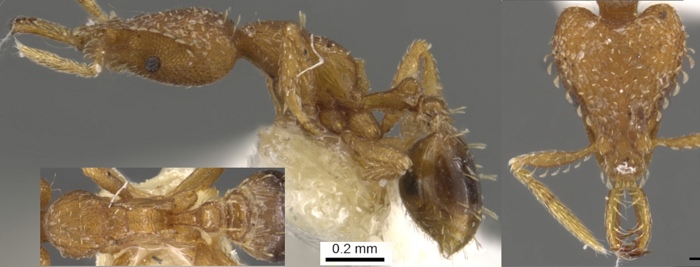 |
Congo Basin - relahyla |
| -- | 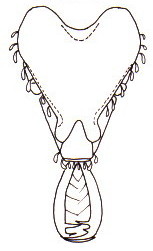 Basigastral
costulae dense and radiating from broad medial clear area; occiput
narrowly and deeply impressed; TL 2.0-2.1 mm, HL 0.54-0.56, HW
0.40-0.43, CI 74-786, MI 46-48, SL 0.28-0.31, SI 70-74; dull yellow Basigastral
costulae dense and radiating from broad medial clear area; occiput
narrowly and deeply impressed; TL 2.0-2.1 mm, HL 0.54-0.56, HW
0.40-0.43, CI 74-786, MI 46-48, SL 0.28-0.31, SI 70-74; dull yellow |
. |
| . |  |
Zimbabwe - dyshaula |
| Preocular notch absent | - | |
| 23 | Blade of left mandible with 1 preapical tooth | 24 |
| -- | Blade of left mandible with 2 preapical teeth | 27 |
| 24 | 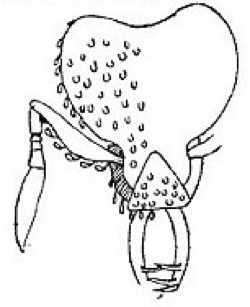 Medium to dark brown;
TL 1.9-2.1 mm, HL 0.47-0.54, HW
0.38-0.43, CI 76-83, MI 40-43, SL 0.24-0.28, SI 62-70; Medium to dark brown;
TL 1.9-2.1 mm, HL 0.47-0.54, HW
0.38-0.43, CI 76-83, MI 40-43, SL 0.24-0.28, SI 62-70; |
. |
| . | 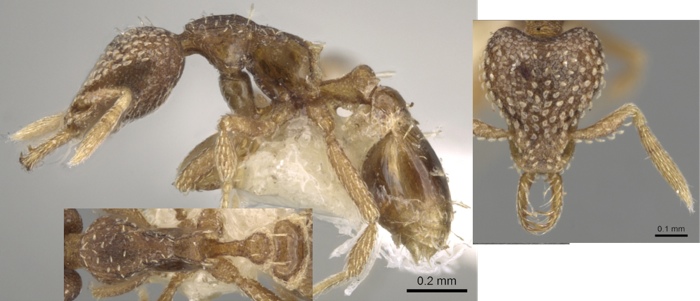 |
Southern Africa - irrorata |
| -- | Brownish-yellow or yellow | 25 |
| 25 |  TL
at least 2.0 mm; apical fork of left mandible with an intercalary
denticle between the spiniform teeth; dorsum of head without a row of 4
erect hairs; head broad; TL 2.0-2.2 mm, HL 0.50-0.53, HW 0.44-0.46, CI
88-90, MI 38-40, SL 0.26-0.27, SI 57-60; brownish-yellow TL
at least 2.0 mm; apical fork of left mandible with an intercalary
denticle between the spiniform teeth; dorsum of head without a row of 4
erect hairs; head broad; TL 2.0-2.2 mm, HL 0.50-0.53, HW 0.44-0.46, CI
88-90, MI 38-40, SL 0.26-0.27, SI 57-60; brownish-yellow |
. |
| . | 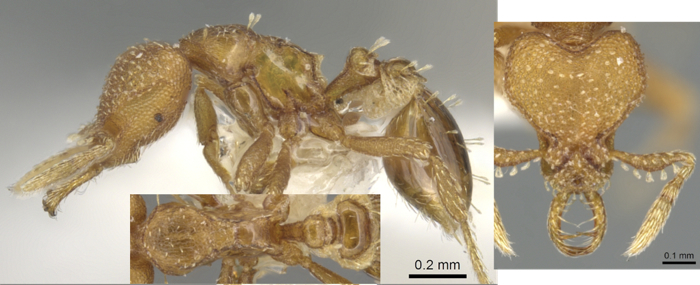 |
East Africa - katapelta |
| -- | TL no more than 1.8 mm; apical fork of left mandible without an intercalary denticle between the spiniform teeth; dorsum of head with a row of 4 erect hairs close to the occiput and an anterior pair; head narrower CI < 80 | 26 |
| 26 | 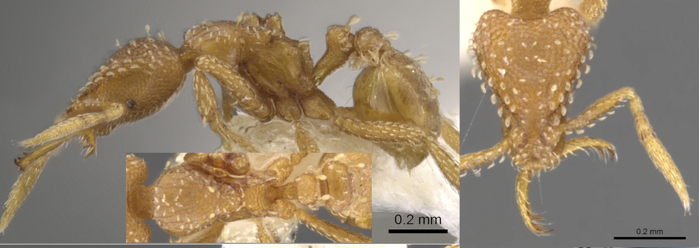 Pronotal humeri each with a
straight stout thickly clavate projecting hair; TL 1.7-1.8 mm, HL
0.45-0.46, HW 0.32-0.34, CI 70-74, MI 37-41, SL 0.24-0.25, SI 73-75;
brownish-yellow Pronotal humeri each with a
straight stout thickly clavate projecting hair; TL 1.7-1.8 mm, HL
0.45-0.46, HW 0.32-0.34, CI 70-74, MI 37-41, SL 0.24-0.25, SI 73-75;
brownish-yellow |
Cameroun & Gabon - paranax |
| -- | Pronotal humeri each with a long fine flagellate projecting hair | 26A |
| 26A | With head in full-face view
mandible increases in width from apex to base; upper scrobe margins
strongly convex; cephalic ground-pilosity spoon shaped; TL 1.8 mm HL
0.45 HW 0.38 SL 0.26 (no images, colour like others assumed) |
South Africa - rakkota |
| -- |  Pronotal humeri each with a long fine flagellate
projecting hair; TL 1.6-1.8 mm, HL 0.41-0.47, HW 0.31-0.34, CI 71-77,
MI 38-42, SL 0.22-0.25, SI 68-75; dull yellow Pronotal humeri each with a long fine flagellate
projecting hair; TL 1.6-1.8 mm, HL 0.41-0.47, HW 0.31-0.34, CI 71-77,
MI 38-42, SL 0.22-0.25, SI 68-75; dull yellow |
Congo Basin into Uganda - dextra |
| Blade of left mandible with 2 preapical teeth | - | |
| 27 | Species with short compact mandibles and short variously broadened scapes | 28 |
| -- | Species with long mandibles and slender scapes | 32 |
| 28 | Head in full face view with post-ocular area essentially heart-shaped; arboreal | 29 |
| -- | Head in full-face view with post-ocular area with straight or near straight sides | 30 |
| 29 | Dorsum of postpetiole finely reticulate-punctate, SI 79; no illustrations | Tanzania - didyma |
| -- | Dorsum of postpetiole smooth, SI 57-63 |
29A |
| 29A |  Pronotal humeri each
with a stout straight laterally
directed hair, with clavate apex; petiole dorsum weakly transversely
striate; TL 2.0-2.1 mm, HL 0.52-0.58, HW 0.38-0.44, CI 70-77, MI 32-36,
SL 0.24-0.26, SI 57-62; dull yellow to brownish-yellow Pronotal humeri each
with a stout straight laterally
directed hair, with clavate apex; petiole dorsum weakly transversely
striate; TL 2.0-2.1 mm, HL 0.52-0.58, HW 0.38-0.44, CI 70-77, MI 32-36,
SL 0.24-0.26, SI 57-62; dull yellow to brownish-yellow |
. |
| . | 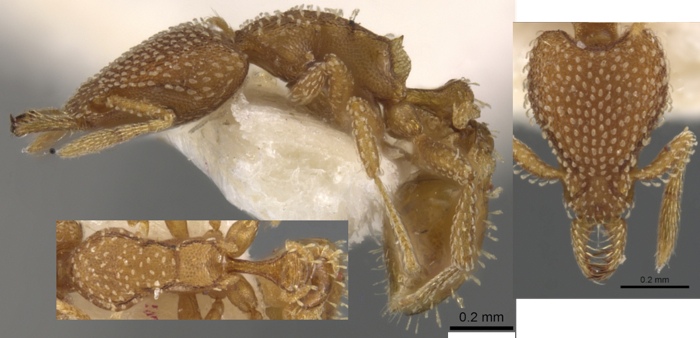 |
West Africa - pallestes |
| -- | Pronotal humeri with projecting hairs; petiole
dorsum punctate; TL 2.4-2.5 mm, HL 0.62-0.66, HW 0.48-0.50, CI 75-77,
MI 35-37, SL 0.30-0.32, SI 60-63; yellowish brown (no available
illustrations) |
South Africa - marleyi |
| 30 | 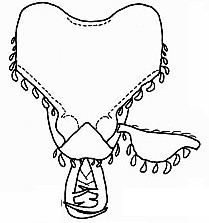 Leading
edge of antennal scape grossly expanded into an enormous anteriorly
projecting lobe; TL 2.0-2.2 mm, HL 0.54-0.60, HW 0.51-0.57, CI 91-97,
MI 34-37, SL 0.28-0.30, SI 52-55; brown Leading
edge of antennal scape grossly expanded into an enormous anteriorly
projecting lobe; TL 2.0-2.2 mm, HL 0.54-0.60, HW 0.51-0.57, CI 91-97,
MI 34-37, SL 0.28-0.30, SI 52-55; brown |
. |
| . | 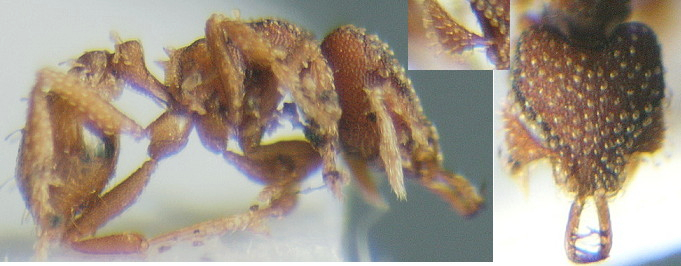 |
Congo Basin into Uganda - tetraphanes |
| -- | Leading edge of antennal scape expanded but less dramatically | 31 |
| 31 | 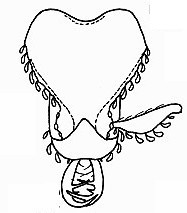 Mandibles
& scapes very short; TL 2.0-2.1 mm, HL 0.53-0.55, HW 0.41-0.44, CI
77-81, MI 26-30, SL 0.24-0.26, SI 55-61; medium brown Mandibles
& scapes very short; TL 2.0-2.1 mm, HL 0.53-0.55, HW 0.41-0.44, CI
77-81, MI 26-30, SL 0.24-0.26, SI 55-61; medium brown |
. |
| . |  |
West Africa - spathoda |
| -- |  Ground
pilosity on head, upper scrobe margins and leading edges of scapes is
of very broad hairs; scapes flattened with leading edges expanded
cf tetraphanes; TL 1.9-2.1 mm, HL 0.50-0.53, HW 0.40-0.43, CI
80-84, MI 36-40, SL 0.26-0.28, SI 63-68; light to medium brown Ground
pilosity on head, upper scrobe margins and leading edges of scapes is
of very broad hairs; scapes flattened with leading edges expanded
cf tetraphanes; TL 1.9-2.1 mm, HL 0.50-0.53, HW 0.40-0.43, CI
80-84, MI 36-40, SL 0.26-0.28, SI 63-68; light to medium brown |
. |
| . |  |
Cameroun, Angola and east into Kenya & Zimbabwe - stygia |
| Species with long mandibles and slender scapes | - | |
| 32 | Pronotal humeri without flagellate hairs | 33 |
| -- |  Pronotal humeri with flagellate hairs Pronotal humeri with flagellate hairs |
36 |
| 33 | 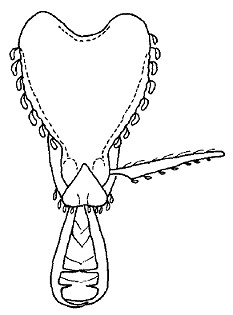 Antennal
scape sharply expanded at the base then evenly tapering to the apex;
mandibles and scapes longer, head narrower; TL 2.2-2.3 mm, HL
0.61-0.64, HW 0.41-0.43, CI 67, MI 49-50, SL 0.35-0.36, SI 84-85;
brownish-yellow Antennal
scape sharply expanded at the base then evenly tapering to the apex;
mandibles and scapes longer, head narrower; TL 2.2-2.3 mm, HL
0.61-0.64, HW 0.41-0.43, CI 67, MI 49-50, SL 0.35-0.36, SI 84-85;
brownish-yellow |
. |
| . | 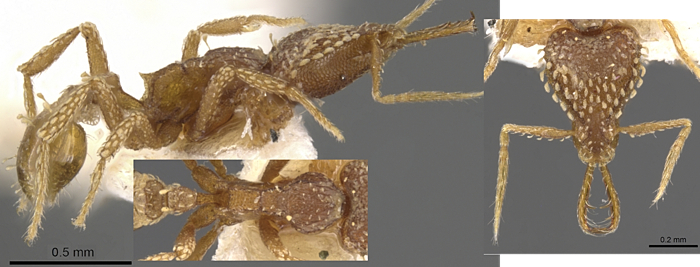 |
Cameroun & Ghana - korahyla |
| -- | Antennal scape broadest about the midlength and narrowing both ways; mandibles and scapes shorter, head broader, MI 35-41, SI 65-75, CI 74-84 | 34 |
| 34 | 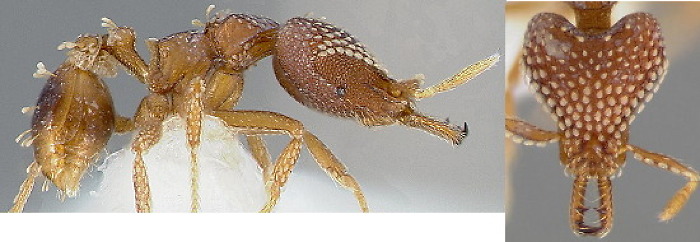 Relatively large with
a broad head and short scape; TL ca 2.4 mm, HL 0.62-0.69, HW 0.54-0.61,
CI 85-90, ML 30, MI 46, SL 0.30-0.34,
SI 54-59 Relatively large with
a broad head and short scape; TL ca 2.4 mm, HL 0.62-0.69, HW 0.54-0.61,
CI 85-90, ML 30, MI 46, SL 0.30-0.34,
SI 54-59 |
Gabon - ultromalyx |
| -- | Postpetiole weakly sculptured and dull | 34A |
| 34A |  Postpetiole
with smooth and shiny dorsum; TL 2.0-2.1 mm, HL 0.54-0.60, HW
0.39-0.46, CI 74-78, MI 38-41, SL 0.30-0.32, SI 68-75; dull yellow Postpetiole
with smooth and shiny dorsum; TL 2.0-2.1 mm, HL 0.54-0.60, HW
0.39-0.46, CI 74-78, MI 38-41, SL 0.30-0.32, SI 68-75; dull yellow |
. |
| . | 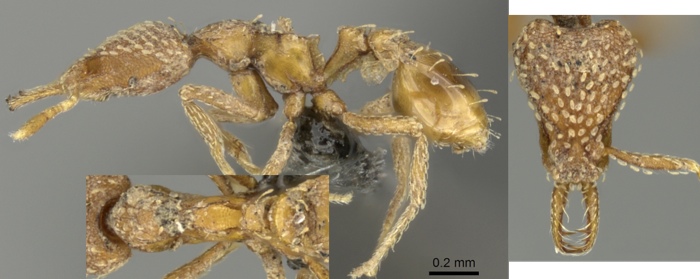 |
eastern Africa - arnoldi |
| -- | Postpetiole weakly sculptured and dull | 35 |
| 35 | 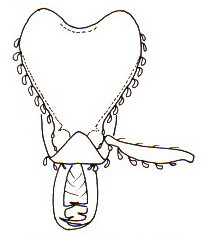 With
quite sparse spatulate hairs; TL 2.0-2.4 mm, HL 0.49-0.60, HW
0.41-0.46, CI 75-80, MI 35-40, SL 0.26-0.32, SI 65-71; light brown With
quite sparse spatulate hairs; TL 2.0-2.4 mm, HL 0.49-0.60, HW
0.41-0.46, CI 75-80, MI 35-40, SL 0.26-0.32, SI 65-71; light brown |
. |
| . | 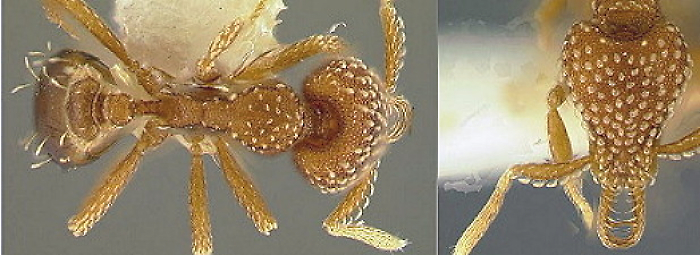 |
Kenya - omalyx |
| Pronotal humeri with flagellate hairs | - | |
| 36 |  Funicular segments 2 and 3 very small so that funiculus
appears to have only 3 segments Funicular segments 2 and 3 very small so that funiculus
appears to have only 3 segments |
37 |
| -- | 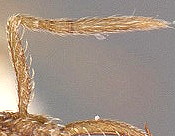 Funicular segments 2 and 3 small but clearly visible Funicular segments 2 and 3 small but clearly visible |
38 |
| 37 |  Lamellate flange bordering
upper scrobe margins distinctly wider than the diameter of the eye,
close to width of scape; petiole node in dorsal view as broad as long;
TL 1.9 mm, HL 0.47, HW 0.37, CI 79, MI 43, SL 0.28, SI 76; light brown Lamellate flange bordering
upper scrobe margins distinctly wider than the diameter of the eye,
close to width of scape; petiole node in dorsal view as broad as long;
TL 1.9 mm, HL 0.47, HW 0.37, CI 79, MI 43, SL 0.28, SI 76; light brown |
Cameroun - bitheria |
| -- | 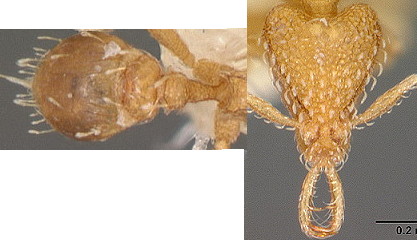 Lamellate flange bordering upper scrobe margins distinctly
narrower than the diameter of the eye, much less than width of scape;
petiole node in dorsal view much broader than long; TL 1.5-1.8 mm, HL
0.42-0.46, HW 0.31-0.35, CI 72-77, MI 40-45, SL 0.22-0.24, SI 68-73;
dull yellow to brownish yellow Lamellate flange bordering upper scrobe margins distinctly
narrower than the diameter of the eye, much less than width of scape;
petiole node in dorsal view much broader than long; TL 1.5-1.8 mm, HL
0.42-0.46, HW 0.31-0.35, CI 72-77, MI 40-45, SL 0.22-0.24, SI 68-73;
dull yellow to brownish yellow |
Ivory Coast & Ghana - nimbrata |
| Funicular segments 2 and 3 small but clearly visible | - | |
| 38 | Postpetiole
node sculptured |
38A |
| -- | Postpetiole node smooth and shining | 39 |
| Postpetiole node sculptured | - | |
| 38A | 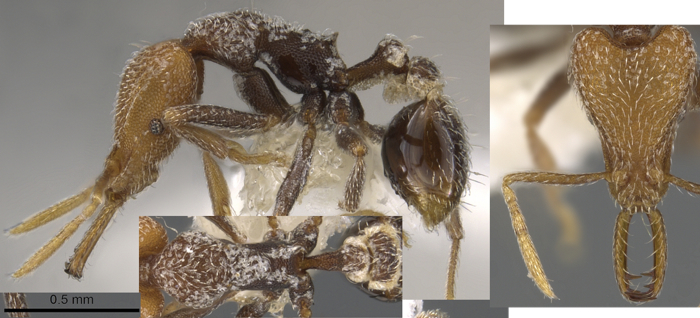 Densely sculptured on
metapleuron and side of propodeum; gaster with relatively long basal
striations (costulae) and a loose pelt of appressed long pubescence; TL
2.3 mm, HL 0.63, HW
0.43, CI 68, MI 52, SL 0.38, SI 88; colour not stated (no illustrations
available) Densely sculptured on
metapleuron and side of propodeum; gaster with relatively long basal
striations (costulae) and a loose pelt of appressed long pubescence; TL
2.3 mm, HL 0.63, HW
0.43, CI 68, MI 52, SL 0.38, SI 88; colour not stated (no illustrations
available) |
Sao Tome & Principe - cenagra |
| -- | 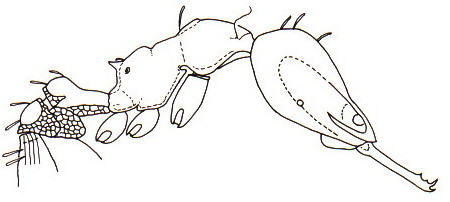 Ground
pilosity on head, upper scrobe margins and
leading edges of scapes is of narrow spatulate hairs; scapes slender
& cylindrical; gaster broader than head; TL 2.3 mm, HL 0.58, HW
0.44, CI 76, MI 43, SL 0.34, SI 77; brownish-yellow Ground
pilosity on head, upper scrobe margins and
leading edges of scapes is of narrow spatulate hairs; scapes slender
& cylindrical; gaster broader than head; TL 2.3 mm, HL 0.58, HW
0.44, CI 76, MI 43, SL 0.34, SI 77; brownish-yellow |
. |
| . | 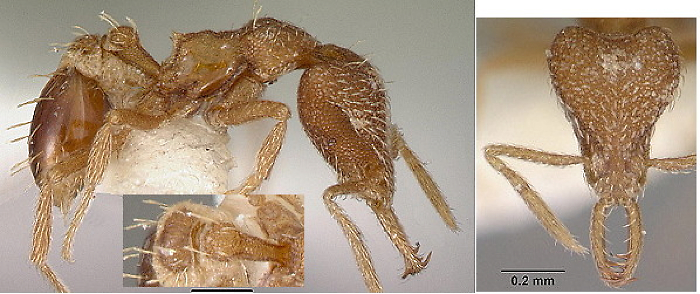 |
Rwanda - murshila |
| Postpetiole node smooth and shining | - | |
| 39 |  Maximum diameter of eye much less than width of scape Maximum diameter of eye much less than width of scape |
40 |
| -- |  Maximum diameter of
eye equal to or greater than width of
scape Maximum diameter of
eye equal to or greater than width of
scape |
43 |
| 40 | Mandibles and scapes longer,
MI 42-50 SI 80-90; left mandible with distal preapical tooth at least
half length of proximal tooth |
41 |
| -- | Mandibles and scapes shorter, MI 42-50 SI 70-77; left mandible with distal preapical tooth distinctly less than half length of proximal tooth | 42 |
| 41 |  Distal preapical
tooth shorter than proximal; MI 45-50;
postpetiole swollen and subglobular; profile of pronotal dorsum evenly
convex in anterior view; TL 2.5-2.6 mm, HL 0.62-0.68, HW 0.44-0.50, CI
69-74, MI
45-50, SL 0.36-0.40, SI 80-90; yellow Distal preapical
tooth shorter than proximal; MI 45-50;
postpetiole swollen and subglobular; profile of pronotal dorsum evenly
convex in anterior view; TL 2.5-2.6 mm, HL 0.62-0.68, HW 0.44-0.50, CI
69-74, MI
45-50, SL 0.36-0.40, SI 80-90; yellow |
. |
| . |  |
South Africa - havilandi |
| -- | 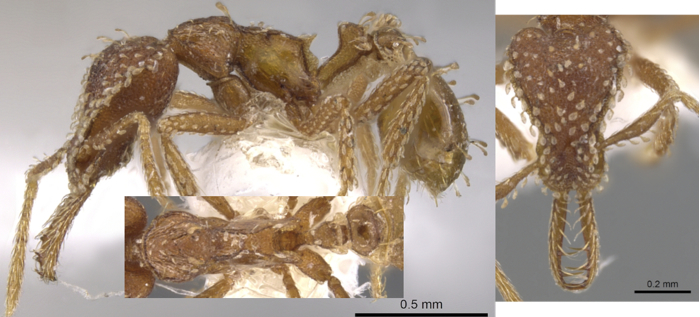 Distal preapical tooth slightly longer than proximal; MI
58; postpetiole neither swollen nor subglobular; profile of pronotal
dorsum an inverted V in anterior view; TL 2.4, HL 0.62, HW 0.44; SL
0.38; PW 0.26 Distal preapical tooth slightly longer than proximal; MI
58; postpetiole neither swollen nor subglobular; profile of pronotal
dorsum an inverted V in anterior view; TL 2.4, HL 0.62, HW 0.44; SL
0.38; PW 0.26 |
Uganda - semicrypta |
| 42 |  Dorsum of head with 4
erect hairs; ground pilosity broadly
spatulate everywhere; in profile postpetiole with ventral spongiform
lobe much larger than equal to the exposed area; L 2.0-2.1 mm, HL 0.52,
HW 0.41, CI 75-79, MI 42-43, SL 0.30-0.32, SI 73-75; yellow Dorsum of head with 4
erect hairs; ground pilosity broadly
spatulate everywhere; in profile postpetiole with ventral spongiform
lobe much larger than equal to the exposed area; L 2.0-2.1 mm, HL 0.52,
HW 0.41, CI 75-79, MI 42-43, SL 0.30-0.32, SI 73-75; yellow |
. |
| . |  |
Zimbabwe - mesahyla |
| -- | Dorsum of head with 6 erect hairs; ground pilosity broadly spatulate everywhere; in profile postpetiole with ventral spongiform lobe much larger than equal to the exposed area; L 2.0-2.1 mm, HL 0.52, HW 0.41, CI 75-79, MI 42-43, SL 0.30-0.32, SI 73-75; yellow | 42A |
| 42A | 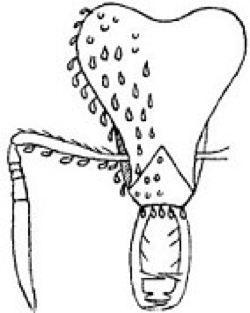 Mesonotum with 2 or 3
(rarely 4) pairs of erect hairs; head capsule longer than its maximum
depth; TL 2.0-2.1 mm, HL 0.54-0.55, HW
0.43, CI 78-80, MI 44, SL 0.30, SI 70; brown (note the Santschi drawing
seems at odds with the Bolton description) Mesonotum with 2 or 3
(rarely 4) pairs of erect hairs; head capsule longer than its maximum
depth; TL 2.0-2.1 mm, HL 0.54-0.55, HW
0.43, CI 78-80, MI 44, SL 0.30, SI 70; brown (note the Santschi drawing
seems at odds with the Bolton description) |
. |
| . | 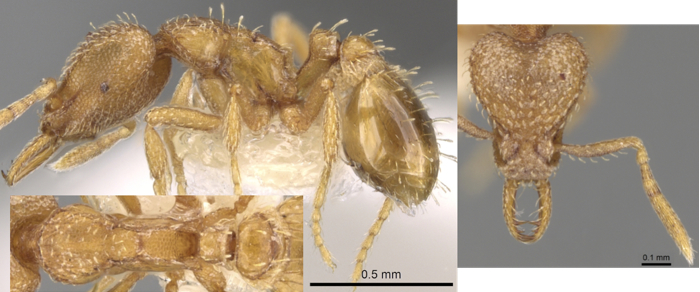 |
South Africa - traegaordhi |
| -- |  Mesonotum
with a single pair of erect hairs; head capsule somewhat shallower and
a less convex profile; TL 2.0-2.2 mm, HL 0.53-0.57, HW
0.42-0.45, CI 79-81, MI 44-48, SL 0.32-0.34, SI 73-76 Mesonotum
with a single pair of erect hairs; head capsule somewhat shallower and
a less convex profile; TL 2.0-2.2 mm, HL 0.53-0.57, HW
0.42-0.45, CI 79-81, MI 44-48, SL 0.32-0.34, SI 73-76 |
South Africa - syntacta |
| Maximum diameter of eye equal to or greater than width of scape | - | |
| 43 | Blackish or blackish-brown | 44 |
| -- | No darker than brown | 45 |
| 44 |  In profile ventral
spongiform lobe on postpetiole much
smaller than visible area of postpetiole dorsum; lamella on propodeal
declivity much reduced; TL 2.3-2.4 mm, HL 0.59-0.62 HW 0.44-0.47 CI
73-78 MI 50-54 SL 0.33-36 SI 72-77; mm; blackish-brown to black In profile ventral
spongiform lobe on postpetiole much
smaller than visible area of postpetiole dorsum; lamella on propodeal
declivity much reduced; TL 2.3-2.4 mm, HL 0.59-0.62 HW 0.44-0.47 CI
73-78 MI 50-54 SL 0.33-36 SI 72-77; mm; blackish-brown to black |
. |
| . |  |
Rwanda & Burundi - adrasora (part) |
| -- | 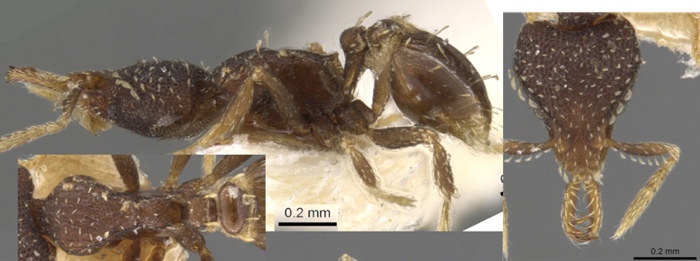 Shorter mandibles and scapes, TL 2.0 mm, HL
0.53-0.57, HW 0.43-0.46, CI 81, MI 40-43, SL 0.26-27, SI 59-60 Shorter mandibles and scapes, TL 2.0 mm, HL
0.53-0.57, HW 0.43-0.46, CI 81, MI 40-43, SL 0.26-27, SI 59-60 |
Cameroun - ettillax |
| 45 |  Upper scrobe margins fringed by a few conspicuous broadly
spatulate to spoon-shaped large hairs, distinctly large than
ground-pilosity of the head; TL 2.3-2.4 mm, HL 0.57-0.60, HW 0.44-0.46,
CI 75-79, MI 47-49, SL 0.30-33, SI 67-73; yellow Upper scrobe margins fringed by a few conspicuous broadly
spatulate to spoon-shaped large hairs, distinctly large than
ground-pilosity of the head; TL 2.3-2.4 mm, HL 0.57-0.60, HW 0.44-0.46,
CI 75-79, MI 47-49, SL 0.30-33, SI 67-73; yellow |
East Africa - rukha (part) |
| -- | 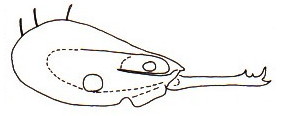 Upper
scrobe margins fringed by many inconspicuous narrowly spatulate
to slender spoon-shaped hairs, similar in size to ground-pilosity of
head Upper
scrobe margins fringed by many inconspicuous narrowly spatulate
to slender spoon-shaped hairs, similar in size to ground-pilosity of
head |
46 |
| Upper scrobe margins fringed by many inconspicuous narrowly spatulate to slender spoon-shaped hairs, similar in size to ground-pilosity of head | - | |
| 46 |  Mandibles
& scapes long, MI 46-50 SI 88-85; petiole node in dorsal view at
least as long as broad; TL 2.4-2.6 mm, HL 0.62-0.70, HW 0.42-0.46, CI
64-70, MI 46-50, SL 0.39-42, SI 88-95; yellowish brown to medium brown Mandibles
& scapes long, MI 46-50 SI 88-85; petiole node in dorsal view at
least as long as broad; TL 2.4-2.6 mm, HL 0.62-0.70, HW 0.42-0.46, CI
64-70, MI 46-50, SL 0.39-42, SI 88-95; yellowish brown to medium brown |
. |
| . | 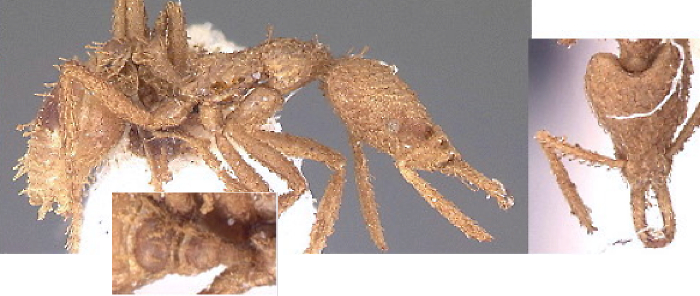 |
Seychelles - scotti |
| -- | Mandibles & scapes shorter, MI 42-46 SI 73-82; petiole node in dorsal view broader than long | 47 |
| 47 |  In
dorsal view all hairs on petiole, postpetiole and base of first gastral
tergite thickened or clavate; smaller, TL 1.8-2.0 mm, HL 0.49-0.52, HW
0.36-0.38, CI 73-75, MI 43-45, SL 0.28-29, SI 76-78; brownish-yellow In
dorsal view all hairs on petiole, postpetiole and base of first gastral
tergite thickened or clavate; smaller, TL 1.8-2.0 mm, HL 0.49-0.52, HW
0.36-0.38, CI 73-75, MI 43-45, SL 0.28-29, SI 76-78; brownish-yellow |
. |
| . | 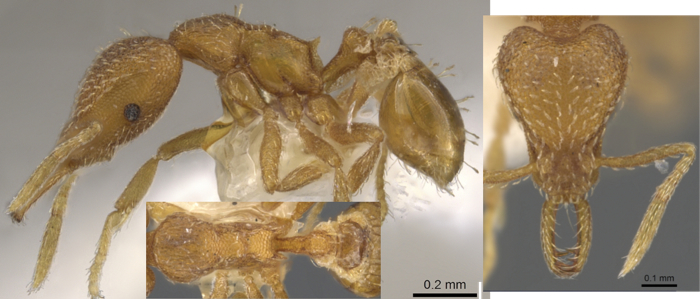 |
West Africa and Congo basin into Burundi - hastyla |
| -- | 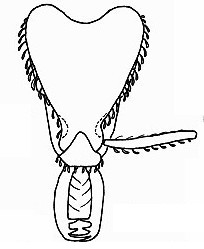 In
dorsal view all hairs on petiole, postpetiole and base of first gastral
tergite simple not thickened; larger, TL 2.2-2.3 mm, HL 0.59-0.61, HW
0.42-0.44, CI 70-73, MI 43-45, SL 0.33-35, SI 75-81; light brownish
yellow In
dorsal view all hairs on petiole, postpetiole and base of first gastral
tergite simple not thickened; larger, TL 2.2-2.3 mm, HL 0.59-0.61, HW
0.42-0.44, CI 70-73, MI 43-45, SL 0.33-35, SI 75-81; light brownish
yellow |
. |
| . | 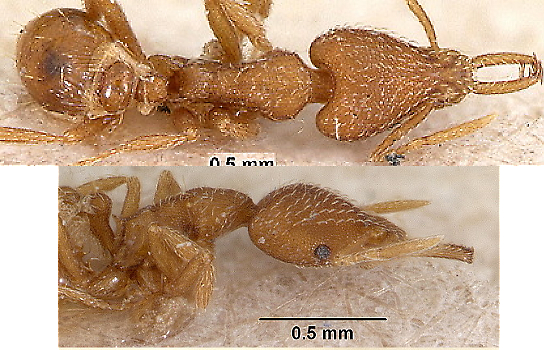 |
Annobon I & Cameroun - zandala |
| -- | 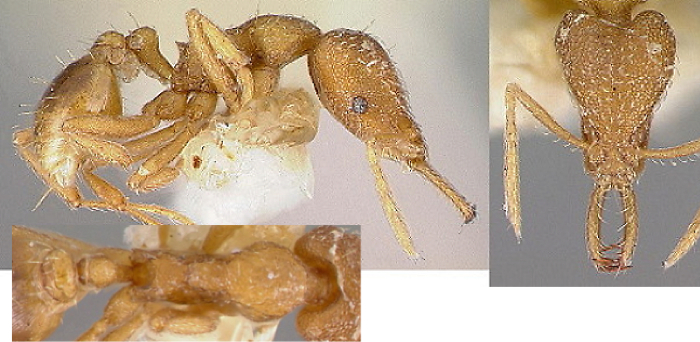 All erect hairs
essentially slender; scape slender for whole length; petiole node
dorslly as long or longer than broad; measurements from
Antweb images: TL ca 2.4 mm, HL 0.62, HW 0.48, CI 78, ML 32, MI 52, SL
0.41, SI 86; light brown All erect hairs
essentially slender; scape slender for whole length; petiole node
dorslly as long or longer than broad; measurements from
Antweb images: TL ca 2.4 mm, HL 0.62, HW 0.48, CI 78, ML 32, MI 52, SL
0.41, SI 86; light brown |
Sao Thomé - sibyna |
| MYRMICINAE Introduction |
© 2007, 2008, 2010, 2011, 2013, 2015 - Brian Taylor CBiol
FSB FRES 11, Grazingfield, Wilford, Nottingham, NG11 7FN, U.K. |
href="strumigenys.htm"